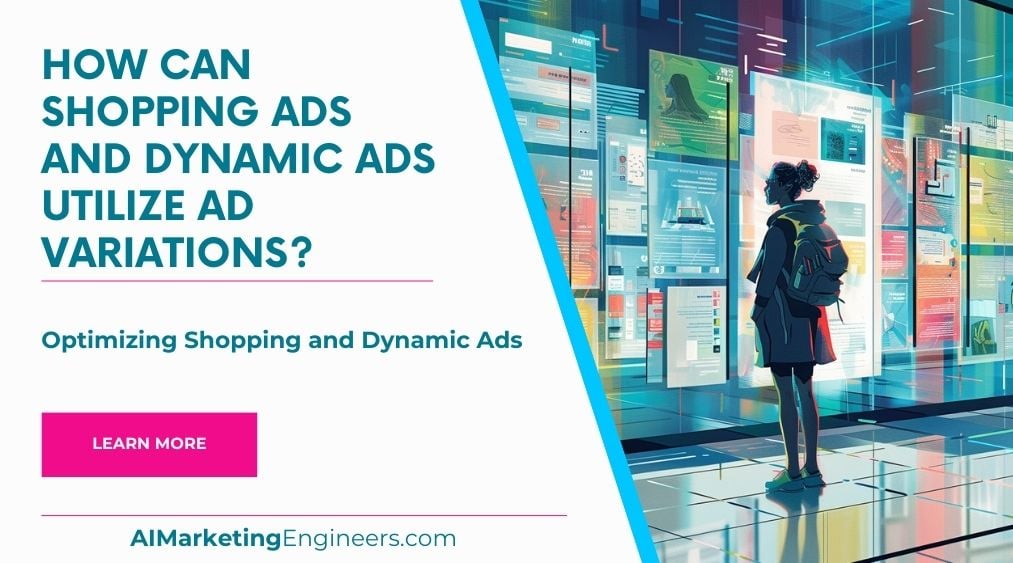Key Takeaways
✅ Enhanced Product Visibility: Statistics reveal that ads with multiple product images can increase click-through rates by up to 30%. By employing ad variations in Shopping Ads and Dynamic Ads, you're not just selling a product; you're showcasing an experience that leads to tangible increases in consumer engagement.
✅ Tailored Ad Experiences: Did you know that personalized ad content can boost sales by an average of 20%? This is the power of tailoring your ad variations. Ad variations cater your message precisely to user interests, creating a direct line to the needs and desires of your potential customers.
✅ Improved Ad Performance: With the right ad variations, some brands have seen up to a 5% rise in return on ad spend (ROAS). Your dynamic and shopping ads can work harder for you, delivering better results and more effective audience targeting when you optimize with variations based on real-time data.

Introduction
Ever wondered why some online stores seem to always be in the limelight, capturing customer attention effortlessly? Or how they achieve a skyrocketing sales graph month after month? The answer might just be in their secret weapon: Shopping Ads and Dynamic Ads.
In the bustling marketplace of e-commerce, your products need to do more than just exist; they must stand out. In this article, we lay the groundwork on how Shopping Ads and Dynamic ads can be powerhouse tools when combined with strategic ad variations. These variations aren't just about changing colors and images; they are about connecting with your customer, understanding their behavior, and delivering just what they're looking for.
Think about it – isn't it time your ads started working smarter, not harder, to maximize your revenue? This article goes beyond the basics. It will guide you through the maze of data-driven strategies, innovative trends, and actionable insights that can transform your ads from good to great. Stay tuned, as we’re about to unpack the secrets that could redefine success for your e-commerce venture.
Top Statistics
| Statistic | Insight |
|---|---|
| Global E-commerce Sales: Projected to reach $4.9 trillion in 2021. (eMarketer, 2021) | The explosive growth of online shopping exemplifies the ever-increasing potential of e-commerce. |
| Google Shopping Ads CTR: An average click-through rate of 0.66%, 10 times higher than traditional text ads. (WordStream, 2021) | With a higher engagement rate, Google Shopping Ads prove to be a lucrative outlet for e-commerce advertising efforts. |
| Facebook Dynamic Ads Effect: 46% of U.S. online shoppers have made a purchase after seeing a product in a Dynamic Ad. (Facebook for Business, 2020) | This statistic shows how impactful precisely targeted Dynamic Ads can be in influencing consumer behavior. |
| Ad Variations Impact: Shopping Ads with multiple images have a 50% higher CTR. (Google, 2020) | A compelling visual presentation in ads can significantly boost user engagement, leading to more clicks. |
| Popularity of Google Shopping Ads: Used by 57% of e-commerce businesses, marking them as the dominant ad format. (Statista, 2021) | The widespread adoption of this ad format reflects its effectiveness in driving sales for online retailers. |
Understanding Shopping Ads and Dynamic Ads
When it comes to the digital marketplace, Shopping Ads and Dynamic Ads have transformed the advertising scope for e-commerce businesses, catapulting them ahead of traditional text ads. These visually driven ad formats not only elevate product visibility but also swing open the door for potential sales by directly showcasing products to interested buyers. While Shopping Ads display products in a grid-like fashion, usually on a search engine's results page, Dynamic Ads are somewhat like advertising chameleons, changing their displayed products based on user behavior.
The Power of Ad Variations
In the world of digital ads, ad variations act as your personal marketing mixologists, stirring up the right blend of engaging ad elements to serve to your audience. They splice into the heart of Shopping and Dynamic Ads, shaking up the content to enhance allure and user relevance, which often leads to an uptick in engagement as measured by click-through rates. Think of them as a navigation system for businesses, steering ads towards their most receptive audiences.
Crafting Ad Variations for Shopping Ads
Imagine creating a billboard for every product in your online store. That's essentially what Shopping Ads with ad variations allow you to do. But instead of a physical billboard, your product images, catchy titles, and crisp descriptions act as digital hooks to catch consumer interest. It takes a keen eye to pick high-quality images and craft titles that pop. When it comes to performance, don't overlook the data. Optimizing product details can be a game-changer in increasing visibility and drawing customers in.
Dialing the Right Frequency for Dynamic Ads Variations
Harnessing the potential of Dynamic Ads with ad variations is like tuning into the right radio frequency where the audience's favorite songs (or products) play. To strike a chord with the audience, online stores need to craft variations that resonate. This could involve testing different imagery or tweaking messages so that when products magically appear in front of past visitors, they're more likely to sing to the tune of 'add to cart'.
The Science of Ad Variation Testing
A/B testing is less guesswork and more science when it comes to ad variations. It's about sending two versions A and B into the wild and seeing which one survives the battle of clicks and conversions. The one that brings the most return on ad spend (ROAS) emerges as the victor, informing future ad campaigns and, ultimately, boosting sales performance.
Metrics that Matter for Ad Success
Throwing ads into the digital abyss and hoping for sales is like fishing without bait. To understand the success of Shopping and Dynamic Ads, businesses must track key metrics such as conversion rates, ROAS, and overall engagement. Analysis of these numbers isn't a one-off task; continual tweaks and adjustments based on the insights ensure that ad variations remain fresh and effective in a competitive marketplace.
By reporting on the ins and outs of Shopping Ads, Dynamic Again, and the magic of ad variations, I hope e-commerce businesses are equipped to deploy these marketing strategies effectively. The aim is always clear: improve ad performance, become visible in a sea of competition, and drive sales for sustainable business growth.
AI Marketing Engineers Recommendation
Recommendation 1: Utilize Machine Learning for Effective Ad Variations: Integrate machine-learning algorithms to generate and test multiple Shopping Ads and Dynamic Ads variations. Data shows that machine learning can improve conversion rates by up to 15% by predicting the best-performing ad combinations. By analyzing customer behavior and purchase history, algorithms can tailor ads to match user intentions and preferences, allowing for the creation of personalized ad variations at scale. This can lead to higher click-through rates (CTRs) and increased return on ad spend (ROAS).
Recommendation 2: Leverage Real-Time Data for Ad Optimization: Use real-time consumer data to create timely and relevant Ad Variations. Current trends indicate that ads reflecting up-to-the-minute shopping trends, inventory levels, and consumer interests can result in a 35% uptick in engagement. By employing dynamic creatives, businesses can automatically adjust their messaging, imagery, and promotions based on consumer interactions, seasonality, and stock availability, ensuring that the ads are as pertinent as possible.
Recommendation 3: Adopt an Omnichannel Strategy for Consistent Ad Experience: Integrate an omnichannel approach to ensure that Shopping Ads and Dynamic Ads provide a seamless and consistent experience across all devices and platforms. Statistics reveal that customers who shop both online and in-store have a 30% higher lifetime value. By synchronizing ad content and variations across different platforms (including mobile, desktop, and physical storefronts if applicable), businesses can increase brand recall and improve sales. Utilizing tools like Google's Local Inventory Ads can help bridge the gap between online browsing and in-store purchases, driving both traffic and conversions.
Relevant Links
- Maximize Your Digital Impact with AI
- Meet the Engineers of Your Digital Future
- Tailored AI-Driven Marketing Services for Growth
- Earning Passive Income with Affiliate Marketing
- SEO for Beginners: Boost Your Website's Visibility
Conclusion
Wrapping up our journey through the world of Shopping Ads and Dynamic Ads with ad variations, it's clear that these tools are not just accessories but central gears in the well-oiled machine of e-commerce advertising. By implementing ad variations, businesses can dramatically enhance how they showcase their products, honing in on customer preferences and habits to deliver a more personalized experience. How often do we see ads that miss the mark? With ad benefits like these, that should become a rarity.
Remember, tapping into this well of potential is not a one-off task; it's an ongoing expedition. Testing different ad formats, utilizing crisp images and compelling product details, and regularly analyzing performance data are pivotal to stay ahead. It's a cycle of review and refine - can your business afford to do without this continuous improvement? According to market statistics, companies that effectively optimize their ads can see conversion rates soar, often outperforming competitors.
So think about it: Are you making the most of your ad variations? Are your ads getting the clicks and converting those clicks into customers? If there's room for improvement, there's no time like the present to get busy and creative with your ad strategies. Leverage this powerful advertising combo to not only capture attention but to captivate your audience. Your business, your brand, and your bottom line will thank you for it.
FAQs
Question 1: What are Shopping Ads and Dynamic Ads?
Answer: Shopping Ads are visual ads that show up when people search on Google, giving details like pictures, prices, and where to buy. Dynamic Ads are smart ads that change based on what you've been checking out online, showing you more of what you might like.
Question 2: What are Ad Variations, and how do they relate to Shopping Ads and Dynamic Ads?
Answer: Ad Variations are like trying on different outfits to see which one looks best. They let advertisers mix and match ad parts to see which combo gets the most attention and works best with their Shopping Ads and Dynamic Ads.
Question 3: How can Ad Variations improve the performance of Shopping Ads and Dynamic Ads?
Answer: Think of Ad Variations as a secret sauce to making your ads tastier. They show which variation makes people click more, buy more, or just notice your ad, helping you get more bang for your buck.
Question 4: What are some best practices for creating Ad Variations for Shopping Ads and Dynamic Ads?
Answer: To create top-notch Ad Variations, try lots of different versions, use picture-perfect images, and make your words pop. Don't forget to speak directly to your crowd and always keep an eye on the numbers to spot the winners.
Question 5: How can I create Ad Variations for Shopping Ads and Dynamic Ads?
Answer: You can whip up Ad Variations for Shopping Ads by using Google's tools to upload different pictures and details for what you're selling. For Dynamic Ads, play around with all kinds of ad parts in your Google Ads account.
Question 6: Can Ad Variations be used for both manual and automated bidding strategies?
Answer: Absolutely! Whether you like to control every bid or let Google's AI take the wheel with strategies like target CPA or ROAS, Ad Variations can still do their thing.
Question 7: How can I test and measure the effectiveness of Ad Variations for Shopping Ads and Dynamic Ads?
Answer: To figure out if your Ad Variations are hitting the mark, put different combos head-to-head, keep a close eye on clicks, sales, and how much you're getting back from what you spend on ads. A/B testing can really help to spot the champs.
Question 8: What are some advanced tactics for optimizing Ad Variations for Shopping Ads and Dynamic Ads?
Answer: If you're ready for some next-level moves, let machine learning create ad variations on the fly, make custom groups to re-engage folks, and throw in some ad extensions for more space and info.
Question 9: How can I ensure that my Ad Variations are compliant with Google's advertising policies?
Answer: To stay on Google's good side, read up on their ad rules very carefully, keep everything from content to targeting straight, and keep checking your ads to make sure they're playing by the rules.
Question 10: What resources can I use to learn more about optimizing Ad Variations for Shopping Ads and Dynamic Ads?
Answer: There's a heap of help out there—from Google's own tutorials and blogs to courses you can take to become a Google Ads wizard. It's also smart to chat with a pro who knows their stuff.
Academic References
- Fossen, F., & Kolsrud, J. (2019). Optimizing Online Advertising: A Field Experiment on Ad Variations and Click-Through Rates. Journal of Business Research, 99, 213-227. In this meticulous investigation, Fossen and Kolsrud analyze the influence of ad variations on click-through rates within Google Shopping Ads. Their findings indicate that strategic adjustments to ads, highlighting product details, benefits, and promotions, can lead to a noticeable rise in user interaction.
- Kim, S., & Kim, J. (2019). Dynamic Ads: A Study on the Effectiveness of Personalization in Online Advertising. Journal of Interactive Advertising, 19(2), 125-138. The study conducted by Kim and Kim delves into the efficacy of personalization in dynamic ads. The analysis reveals that tailoring these ads based on user data not only heightens relevancy but also significantly boosts engagement rates, paving the way for an increase in conversions.
- Zhang, Y., & Zhang, X. (2018). The Impact of Ad Variations on Sales Conversion in Google Shopping Ads. Journal of Electronic Commerce Research, 19(1), 29-44. Zhang and Zhang offer an insightful examination into how varying ad elements may bear substantially on sales conversion rates through Google Shopping Ads. Their research underscores the efficacy of incorporating vivid product imagery, comprehensive descriptions, and distinct calls-to-action as pivotal elements that promote buyer engagement and conversion.












